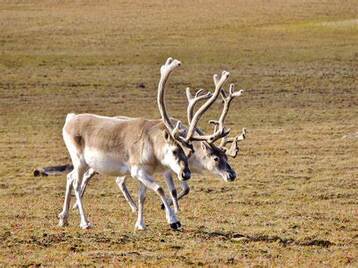Reindeer Sausage 1972

A reindeer is another name in Alaska for a caribou that has been harvested from a herd that is domestically managed.
Here is how Alaskan reindeer sausage is made:
"Alaskan Reindeer Sausage is made with Reindeer meat, Pork and Beef, seasoned with white pepper, coriander, and other spices, then alder smoked for amazing flavor perfection. Reindeer Sausage are perfect for barbecuing on those hot summer days and can serve as an impressive treat for the holidays. These are Fully Cooked Polish Style Sausage." Alaskan Reindeer Sausage by the pound - Tanner's Fish - Tanner's Alaskan Seafood (tannersfish.com)
In 1974 I hunted with a group of teacher friends. We drove to Sheep Mountain Lodge about 100 miles north of Anchorage. There we took three snowmobiles about 20 miles north on a snow packed trail, where we encountered the Nelchina herd of caribou, about 10,000 animals. These animals ran in small groups of 12-15, with a “follow the leader” mentality. If you saw an animal, you knew there would be a string of them!
We killed and rough-dressed three of the animals and hauled them to the snowmobile trail, planning to take them out by dragging them behind the three snowmobiles. But there was a problem. Click HERE and in the third section you can find out what happened!!
In 1977, working with the Bureau of Land Management, I kept maps and records on a fire near Candle, Alaska, 100 miles east of Nome. That fire threatened land given to the Native Alaskans living in that area as the grazing ground for a major herd of caribou (reindeer!) their Native Corporation managed as a business. Much of the Alaskan reindeer sausage sold in stores in Alaska came from that program. The lichens the animals ate could take up to 100 years to revegetate after a burn, so we were tasked with preventing a wildfire from burning over that land mass, despite no people living there! Marion Weiler, a biologist/maps and records officer with BLM, placed photo point markers in carefully mapped areas that were burnt over by the file. He photographed and recorded the exact locations for later analysis.
Just this past year, a biologist from Fairbanks used Marion's old records to return to the same spots and record the growth in the old burn area. Perhaps in another 50 years a new biologist will visit the same locations?
Here is how Alaskan reindeer sausage is made:
"Alaskan Reindeer Sausage is made with Reindeer meat, Pork and Beef, seasoned with white pepper, coriander, and other spices, then alder smoked for amazing flavor perfection. Reindeer Sausage are perfect for barbecuing on those hot summer days and can serve as an impressive treat for the holidays. These are Fully Cooked Polish Style Sausage." Alaskan Reindeer Sausage by the pound - Tanner's Fish - Tanner's Alaskan Seafood (tannersfish.com)
In 1974 I hunted with a group of teacher friends. We drove to Sheep Mountain Lodge about 100 miles north of Anchorage. There we took three snowmobiles about 20 miles north on a snow packed trail, where we encountered the Nelchina herd of caribou, about 10,000 animals. These animals ran in small groups of 12-15, with a “follow the leader” mentality. If you saw an animal, you knew there would be a string of them!
We killed and rough-dressed three of the animals and hauled them to the snowmobile trail, planning to take them out by dragging them behind the three snowmobiles. But there was a problem. Click HERE and in the third section you can find out what happened!!
In 1977, working with the Bureau of Land Management, I kept maps and records on a fire near Candle, Alaska, 100 miles east of Nome. That fire threatened land given to the Native Alaskans living in that area as the grazing ground for a major herd of caribou (reindeer!) their Native Corporation managed as a business. Much of the Alaskan reindeer sausage sold in stores in Alaska came from that program. The lichens the animals ate could take up to 100 years to revegetate after a burn, so we were tasked with preventing a wildfire from burning over that land mass, despite no people living there! Marion Weiler, a biologist/maps and records officer with BLM, placed photo point markers in carefully mapped areas that were burnt over by the file. He photographed and recorded the exact locations for later analysis.
Just this past year, a biologist from Fairbanks used Marion's old records to return to the same spots and record the growth in the old burn area. Perhaps in another 50 years a new biologist will visit the same locations?